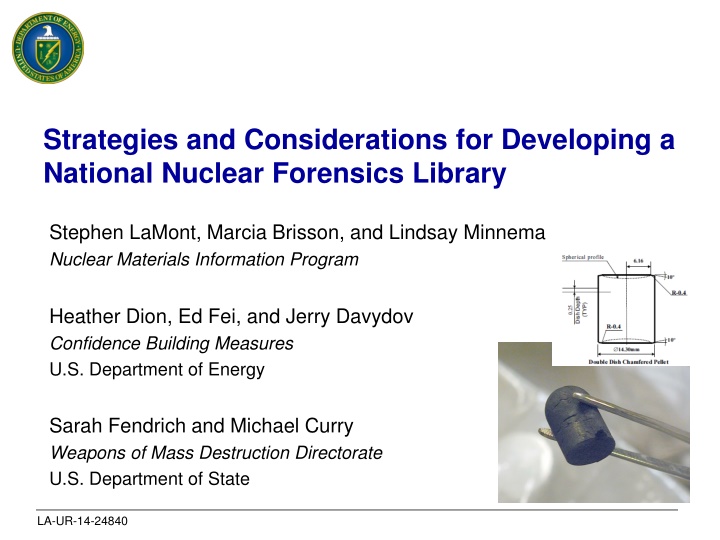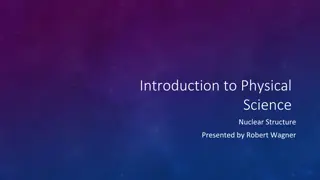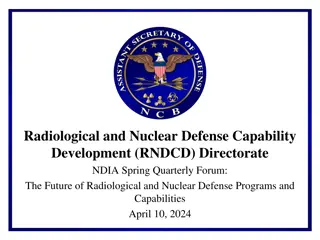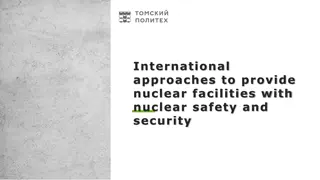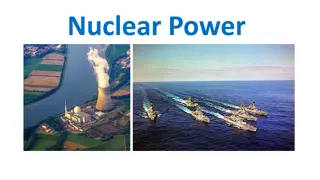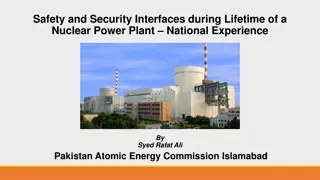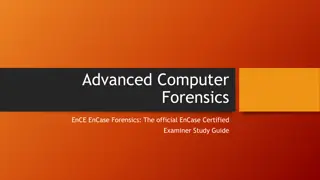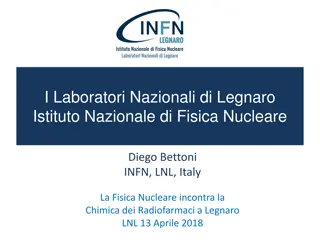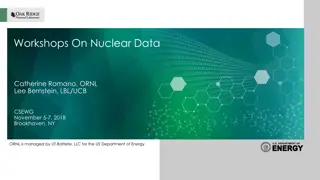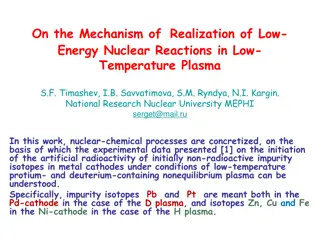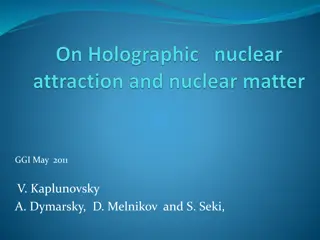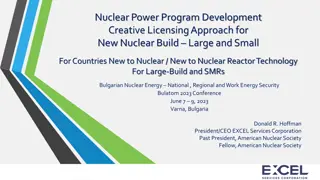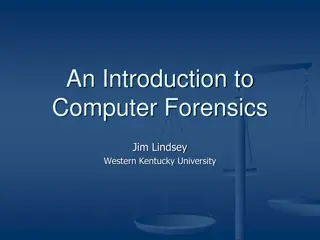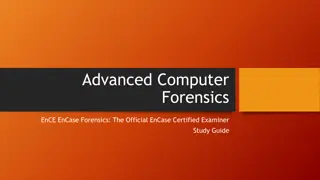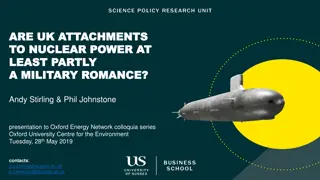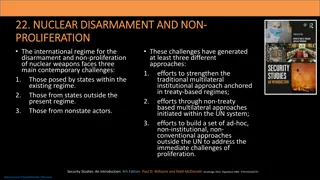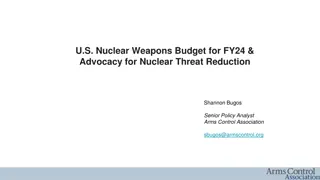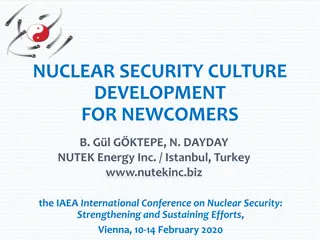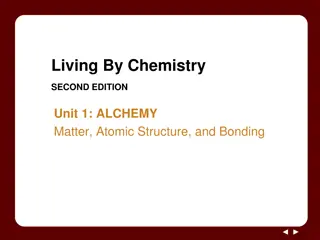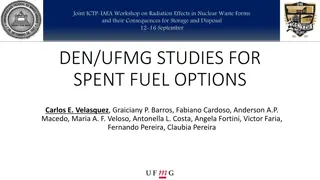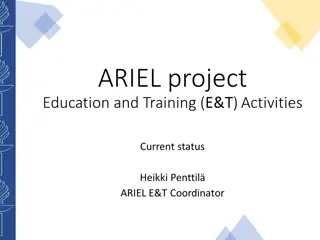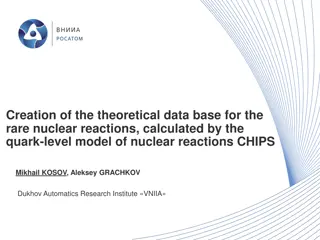Strategies for Developing a National Nuclear Forensics Library
Nuclear forensics involves comparing data from unknown sources with known material characteristics to determine their origin. Establishing a national nuclear forensics library is crucial for identifying nuclear materials and promoting international cooperation in investigations. Key elements include information on material location and characteristics, expertise in material identification, and mechanisms for comparative assessments. Verification of material consistency is vital, and a library provides timely and confident responses to the question: "Is it ours?"
Download Presentation

Please find below an Image/Link to download the presentation.
The content on the website is provided AS IS for your information and personal use only. It may not be sold, licensed, or shared on other websites without obtaining consent from the author.If you encounter any issues during the download, it is possible that the publisher has removed the file from their server.
You are allowed to download the files provided on this website for personal or commercial use, subject to the condition that they are used lawfully. All files are the property of their respective owners.
The content on the website is provided AS IS for your information and personal use only. It may not be sold, licensed, or shared on other websites without obtaining consent from the author.
E N D
Presentation Transcript
Strategies and Considerations for Developing a National Nuclear Forensics Library Stephen LaMont, Marcia Brisson, and Lindsay Minnema Nuclear Materials Information Program Heather Dion, Ed Fei, and Jerry Davydov Confidence Building Measures U.S. Department of Energy Sarah Fendrich and Michael Curry Weapons of Mass Destruction Directorate U.S. Department of State LA-UR-14-24840
Overview Nuclear forensics is a comparative science where data from unknowns can be compared with known material characteristics to assess nuclear or other radioactive material provenance Hence, the need exists for: Information on the location and characteristics of nuclear and other radioactive material produced, used or stored within the State Expertise in identifying and interpreting the characteristics of material produced, used or stored within the State A mechanism for conducting comparative assessments of material encountered out of regulatory control A mechanism for encouraging international cooperation during nuclear forensics investigations The administrative organization of data and subject matter expertise forms the framework for a national nuclear forensic library LA-UR-14-24840
Fundamental Requirement: Is it ours? If nuclear material is found outside of administrative controls anywhere in the world, then each country should be able to answer the question: Is this consistent with our material? Verifying inventory may confirm that material does not appear to be missing, but that may not be sufficient A national nuclear forensic library is extremely valuable for answering this question with timeliness and confidence LA-UR-14-24840
National Nuclear Forensics Library Model NNFLs give countries the capability to identify materials used, produced or stored within their borders What is needed to answer is it ours? Options for Success Requirements National-level mandate Defined query protocol Organize necessary resources Government and industrial material holders Data Subject matter expertise Centralized or formally federated databases Formal effort to understand useful material characteristics Accompanying material archive and analysis capability LA-UR-14-24840
General Process for Building a NNFL Establish mandate to build a NNFL Coordinate with subject matter experts, regulators, and law enforcement Identify materials for inclusion in NNFL and existing data Evaluate characteristics necessary for comparative analysis Compare necessary characteristics against existing data Identify and fill gaps in data (may require laboratory analysis) Build or modify databases as needed Develop comparative analysis tools as required LA-UR-14-24840
NNFL Effort and Complexity The level of effort required to develop a library varies greatly between countries NNFL complexity is largely dictated by the nuclear activities within a state Not every country needs to capture the same material characteristics to have a functional NNFL Quantity of radioactive sources Variety of radioactive sources Quantity of nuclear materials Variety of nuclear materials Production or processing of nuclear or radioactive materials Research and development activities Complexity of NNFL and Associated Materials Databases LA-UR-14-24840
Practical Approach to Implementation To date, guidance for developing a NNFL has not adequately addressed variable complexity of nuclear activities Proposed approach Evaluate nuclear activities to guide NNFL development Adapt general guidance already available to categories (e.g. draft IAEA guidance) This approach should improve understanding regarding the level of effort necessary to attain a functional national nuclear forensics library LA-UR-14-24840
Nuclear Fuel Cycle Activities and Complexity Group 1 Group 2 Group 3 Group 4 Group 5 Radioactive Sources Mining & Milling Radioactive Sources Mining & Milling Research Reactors Nuclear Power Plants Radioactive Sources Mining & Milling Research Reactors Nuclear Power Plants Fuel Fabrication Nuclear R&D Isotope Production Enrichment Reprocessing Radioactive Sources Mining & Milling Research Reactors Nuclear Power Plants Fuel Fabrication Nuclear R&D Enrichment Reprocessing Isotope Production Nuclear Weapons Radioactive Sources Mining & Milling Research Reactors Nuclear Power Plants Fuel Fabrication Nuclear R&D Isotope Production Increasing NNFL Complexity LA-UR-14-24840
IAEA Member States and Fuel Cycle Activities IAEA Member States Group 1 (159) Group 2 (60) Group 3 (23) Group 4 (16) Group 5 (8) For 219 IAEA Member States, developing a functional NNFL should be a relatively easy task (Groups 1&2) LA-UR-14-24840
Group 1 & 2 Countries Most countries fall into these two categories National radioactive source registries may largely fill these nations NNFL needs Supplemental information may be necessary to uniquely identify some sources Additional information on reactor or non-accountable source materials may need to be captured separately or as part of an existing source registry LA-UR-14-24840
Group 1 & 2 NNFL Regulator s licensing or tracking system likely has most of the information necessary for a NNFL Some additional information might be required for non-sealed source materials Not all recommended characteristics may be needed for all libraries Characteristics table for radiological sources* Characteristic Characteristics Data elements Notes Source type (emission type, use type) Quantity Description and dimensions Encapsulation or cladding Serial number Radiograph/photograph Shipping/receiving history Identifying information from the supplier Description of the source/package Activities in Bq, [neutron/sec] with a radioactive decay reference date Activity Reference date of the activity Neutron intensity/yield Source activity information Compound name Element concentration Element concentration uncertainty Isotope name Isotope activity Isotope activity uncertainty Chemical form Elemental concentrations (in matrix) Expressed in g/g sample Expressed as activities in Bq, include reference date Major and minor isotopes * IAEA National Nuclear Forensics Libraries document provided to Nuclear Security Summit participants 11 LA-UR-14-24840
Group 3, 4, & 5 Countries NNFL s are supported by source registries, nuclear materials accountancy information, production data Additional material characteristic information is required to uniquely identify most materials Analytical measurements and subject matter expert evaluation necessary to identify distinguishing characteristics Candu Fuel Uranium enrichment cascade PuO2 LA-UR-14-24840
Group 3, 4, & 5 Level of Effort Substantial effort may be required to establish a functional national nuclear forensic library Large number of material types Understanding of material flow through fuel cycle Statistical expertise for identifying material populations and comparative analyses Organizing available data and subject matter expertise essential 7 6 5 Data Element 2 Cluster 1 4 Cluster 2 Cluster 3 3 2 seized sample (hypothetical) 1 0 0 1 2 3 4 5 6 7 8 Data Element 1 LA-UR-14-24840
Establishing an NNFL Group Direct comparison of material characteristic data Subject matter expertise, difficulty of gathering data, sophistication of comparative analysis tools, and overall level of effort gradually increase with each group level 1 Data from regulator / source or fuel manufacturers 2 Fuel cycle / isotope production knowledge 3 Analytical measurement capability 4 5 Specialized databases and comparative analysis tools LA-UR-14-24840
Summary Each country s situation is unique with regard to nuclear activities and NNFL development Necessary mandate, organization, and technical approach The characteristics included in each country s library may be different for the same materials The sophistication of databases and comparative analysis tools increase with scale of nuclear activities Groups of countries can be defined based on complexity and variety of activities Facilitates developing guidance for groups of countries with similar NNFL needs Important for establishing the level of effort required to develop a NNFL early in the process LA-UR-14-24840
Acknowledgements John Wacker Pacific Northwest National Laboratory Frank Wong Department of Homeland Security Ian Hutcheon, Mike Kristo, Martin Robel, Kim Knight Lawrence Livermore National Laboratory LA-UR-14-24840
Backup Slides LA-UR-14-24840
The National Nuclear Forensic Library Model National nuclear forensics libraries Organized data describing nuclear material characteristics (measured and modeled) Enables comparative analysis by subject matter experts during forensics investigations Centralized or distributed, but rapidly accessible when needed Complexity tailored to each country s situation National point-of-contact (POC) Single national level POC to respond to international queries UO3 National library and point-of-contact model designed to protect proprietary and sensitive nuclear material characteristics and inventories LA-UR-14-24840
